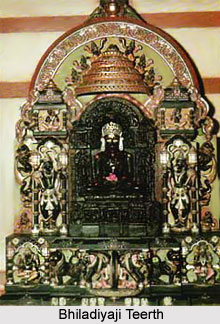 Bhiladiyaji teertha located in the Indian state of Gujarat is a Jain pilgrimage centre. It is situated at a distance of 40 kms from Bhiladi town in the Deesa Taluka of Banaskantha district. The temple is dedicated to Lord Parshvanatha, the twenty-third Jain Tirthankara.
Bhiladiyaji teertha located in the Indian state of Gujarat is a Jain pilgrimage centre. It is situated at a distance of 40 kms from Bhiladi town in the Deesa Taluka of Banaskantha district. The temple is dedicated to Lord Parshvanatha, the twenty-third Jain Tirthankara.
History of Bhiladiyaji Teertha
According to history Bhiladiyaji Teertha dates back to the ancient times. As per the early Jain scriptures this sacred place was earlier known as Bhimapalli. It is believed that the idol of Shri Bhiladia Parshvanatha Bhagwan was formally installed at the auspicious hands of Shri Kapila Kevali. An early reference of V.S. 1218 suggests that Shri Shrenikakumar had married a beautiful Bhil girl. Later he constructed this town and named the town after her name. At that time the town was in a flourishing state. There were hundred and twenty-five temples with peaks, one hundred and twenty - five wells and many stepped-wells. The temple was renovated by Oswal Shreshthi Shri Bhuvanpal Shah in V.S. 1317. The town was however destroyed in the year 1353 because of Muslim invasions. Under the inspiration of Dharmachandbhai Kamdar this town located near the temple was resettled in the year 1872 of the Vikram Samvat Era. The temple remained in a ruined state until it was repaired and renovated by the Sharavakas of Bhiladi town in V.S. 1936. The last renovation of the temple took place in V.S. 2027 under the auspices of Acharyashri Bhadrasurisvarji Maharaj Saheb. At this time a miraculous incident took place. On the tenth day of the bright half of the month of Jeth when the idol of Lord Parshvanatha was being taken out from the cellar a divine power gripped it and wild bees began to fly. Thus the idol was reinstalled in the same place. The temple is visited by many devotees from far off places who come here to offer their prayers to the Lord and get their wishes fulfilled. The temple thus serves as a source of solace and faith for many pilgrims.
Temple of Bhiladiyaji Teerth
The temple of Bhiladiyaji Teerth is dedicated to Lord Parshvanatha. Here the lord is known as Shri Bhiladia Parshvanath Bhagavan. The temple is very old and stands as a unique example of ancient art and architecture. It is two storied and is adorned with three peaks. The idol of the Lord is of black in colour and is 53 cm in height. It is seated in a padamasana posture. The temple organises few annual functions here. It has provisions for dharamshalas or rest houses for the pilgrims. These are well equipped with all modern facilities.
Bhiladiyaji Teerth is well connected to rail, road and air. The nearest railway station of Bhiladiyaji is at a distance of half a kilometre from the temple. The trust of the temple also arranges auto - rickshaws for the pilgrims. Taxis and buses are also easily available. Roads are being developed for easy reach to the temple. Of the easiest road to the temple is at 25 Kilometers from Deesa.




















